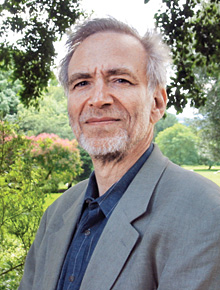Summer 2010: Of Note

iStockphoto.com

Courtesy Melvin Konner
In Their Minds’ I
A professor’s broad view of the development of children provides insights into our own
By Mary J. Loftus
Watch a toddler—any toddler, anywhere in the world—struggle to rise up from crawling, balance unsteadily on two feet, and take a few wobbly steps, and you can see the history of natural selection and human evolution played out in microcosm.And, if you watch the parent waiting to catch the child, you begin also to understand the impact of social attachment—also known as love, says Samuel Candler Dobbs Professor Melvin Konner.
In his latest book, The Evolution of Childhood: Relationships, Emotion, Mind (Harvard University Press, 2010), Konner, a physician and anthropologist, provides a Darwinian interpretation of a child’s development from infancy to adolescence—a journey rooted in genetically inherited traits and brain development, yet deeply influenced by emotions and social interactions.
This weighty tome, which fills more than nine hundred pages, was a long time in the making and spanned many scientific revolutions. “I thought it would take three years; it took three decades,” Konner says. “During that time, advances in the fields of sociobiology, evolutionary psychology, behavior genetics, and brain development greatly enhanced our understanding of childhood.”
Significant advances also took place in the lab, with functional brain imaging and accelerating gene technology. “Genes are no longer an abstraction,” he says, “and the hard work of figuring out how they shape the brain, and therefore behavior, is under way.”
While genetics might lay the groundwork, however, the environment often provides the final verdict.
Advances in brain imaging allow for important, real-time insights into the working of the child and adolescent’s cognitive processes and mental life. “Before we could look at brains only after death, or very crudely during life, supplement those meager findings with evidence from the study of other animals, and then guess how the brain generates its major product—behavior,” Konner says. “Now we can watch brain circuits in action, down to the level of millimeters, while mental processes are going on.”
All of this research suggests that the evolution of intelligence and mind is driven not just by primal needs such as making tools and remembering food locations, he says, but by the vital need to negotiate emotions and relationships.
Insights about our own development, Konner posits in the book’s prologue, stem from a deeper grasp of our place in the natural world: “Our understanding of attachment depends, in part, on observations of the following behavior of goslings; our understanding of brain plasticity on changes in the pyramidal neurons of jewelfish; our understanding of kinship on the social lives of honeybees; and our understanding of the long, slow human childhood on the rise and fall of populations of flowers.”
We are here, Konner points out, because our distant human ancestors were able to meet the challenge of parenting—of keeping their fragile yet resilient progeny alive to begin the cycle anew. Parenting, he says, has never taken place in isolation: we are the products not only of families, but of tribes and communities.
Konner’s evolutionary view of a contemporary child’s development from prepubescence to young adulthood would be helpful to anyone trying to respond appropriately to a thirteen-year-old’s boundless curiosity or an eighteen-year-old’s contradictory behaviors.
Middle childhood, he says, is a period of slower growth and calmer hormonal flux, ideal for a uniquely human enterprise: the acquisition of large stores of cultural knowledge. “The hard-to-control emotions of early childhood are left behind and replaced by logical patterns of thought and the ability to think about thought itself,” Konner says. “Across cultures, it is a time when more is expected of children and more responsibility assigned.”
This maturation doesn’t stop abruptly at high school graduation. The frontal cortex and other areas needed for mature thought are not fully developed until around age twenty, he says.
As grounded in scholarship and scientific inquiry as this book may be, Konner’s personal view of children as beings of awe and wonder, mystery and complexity, supplies some of its most engaging passages.
“You hold your child in your arms for the first time, and you imagine a world of influence that you do not really have,” he writes. “The sleek intertwining of heredity and environment, by which their mother and I were going to produce three, by our lights, almost perfect people yielded instead three marvelous works-in-progress, approaching perfection by their own lights. I will never know quite why they turned out the way they did. Life is not a controlled experiment.”